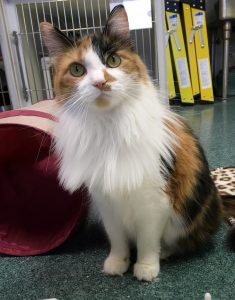If you’ve ever had a cat lick you, then you know just how rough their tongues are. That’s because they have tiny little hook-like structures on their tongue which catch loose hair and dirt when they groom themselves. That works great for keeping your kitty clean but in some instances all that hair moving from the tongue into the intestinal tract can cause a problem. That problem is known as a hairball.
The majority of hair that is loosened during grooming passes right through the digestive system with no problem, but if some hair stays in the stomach it can form a hairball. Usually your cat will vomit up the hairball and it ends up on your floor (or bed or sofa!) looking like a short hot dog shaped mass of hair.
It makes sense that hairballs can be more problematic for long-haired breeds, such as Persians, Himalyans and Main Coons. Cats that shed a lot or overgroom are also more likely to have hairballs like long haired cats because they swallow more fur.
It can be downright distasteful to watch a cat rid himself of a hairball. He may croon his neck, retch, gag and hack while trying to move the hairball from his stomach to your floor. It’s not uncommon for a cat to produce a hairball every week or two.
You can help reduce the potential for hairballs by brushing your cat daily. This will allow you to remove the hair from your cat before he ingests it. There are also various products and foods are the market that address hairballs, but be sure to discuss these with your veterinarian before using them.
In some instances, a hairball will move from the stomach to the intestines instead of being expelled through vomiting. This can become a serious issue for your cat as the hairball may cause a life threatening blockage in the digestive tract. If your cat has ongoing retching, gagging or vomiting without producing a hairball that is cause for concern. It’s important to keep an eye on your cat’s appetite and activity. If he quits eating, becomes lethargic, is constipated or has diarrhea consult with your veterinarian.
While hairballs are certainly unpleasant, they are a side effect of a normal, healthy well-groomed cat.

